Broadcom BRCM1050 802.11g/Draft 802.11n WLAN PCI-E Minicard User Manual Host
Broadcom Corporation 802.11g/Draft 802.11n WLAN PCI-E Minicard Host
Broadcom >
Contents
User Manual Host

SETUP GUIDE
INSPIRON™

SETUP GUIDE
Regulatory model: P08T Regulatory type: P08T001
INSPIRON™

3
Notes, Cautions, and Warnings
NOTE: A NOTE indicates important information that helps you make better use of your
computer.
CAUTION: A CAUTION indicates either potential damage to hardware or loss of data and tells
you how to avoid the problem.
WARNING: A WARNING indicates a potential for property damage, personal injury, or death.
__________________
Information in this document is subject to change without notice.
© 2010 Dell Inc. All rights reserved.
Reproduction of these materials in any manner whatsoever without the written permission of Dell Inc. is strictly forbidden.
Trademarks used in this text:
Dell
, the
DELL
logo,
Inspiron
,
YOURS IS HERE
, Solution Station, and
DellConnect
are
trademarks of Dell Inc.;
Intel
is a registered trademark and
Atom
is a trademark of Intel Corporation in the U.S. and other
countries;
Microsoft
,
Windows
, and the
Windows
start button logo are either trademarks or registered trademarks
of Microsoft Corporation in the United States and/or other countries;
Bluetooth
is a registered trademark owned by
Bluetooth SIG, Inc. and is used by Dell under license;
Blu-ray Disc
is a trademark of the Blu-ray Disc Association.
Other trademarks and trade names may be used in this document to refer to either the entities claiming the marks and
names or their products. Dell Inc. disclaims any proprietary interest in trademarks and trade names other than its own.
October 2010 P/N KFPFD Rev. A00
Setting Up Your Laptop . . . . . . . . . . . . . . . . .5
Before Setting Up Your Computer . . . . . . . . . 5
Connect the AC Adapter . . . . . . . . . . . . . . . .6
Press the Power Button . . . . . . . . . . . . . . . . .7
Set Up Microsoft Windows. . . . . . . . . . . . . . . 8
Create System Recovery Media
(Recommended). . . . . . . . . . . . . . . . . . . . . . . .9
Install the SIM Card (Optional). . . . . . . . . . . 10
Enable or Disable Wireless (Optional). . . . . 14
Connect to the Internet (Optional) . . . . . . . . 17
User Interface Modes . . . . . . . . . . . . . . . . . . 19
Set Up the Tablet Mode. . . . . . . . . . . . . . . . . 20
Right View Features. . . . . . . . . . . . . . . . . . . . 22
Using Your Inspiron Laptop. . . . . . . . . . . . .22
Left View Features. . . . . . . . . . . . . . . . . . . . . 24
Status Lights and Indicators. . . . . . . . . . . . . 26
Disabling Battery Charging. . . . . . . . . . . . . . 27
Computer Base and Keyboard Features . . . 28
Touch Pad Gestures. . . . . . . . . . . . . . . . . . . . 30
Multimedia Control Keys. . . . . . . . . . . . . . . . 32
Display Features . . . . . . . . . . . . . . . . . . . . . . 34
Using the Touch Screen . . . . . . . . . . . . . . . . 36
Software Features . . . . . . . . . . . . . . . . . . . . . 40
Dell DataSafe Online Backup . . . . . . . . . . . . 41
Free Fall Sensor . . . . . . . . . . . . . . . . . . . . . . . 41
Solving Problems . . . . . . . . . . . . . . . . . . . . .42
Beep Codes . . . . . . . . . . . . . . . . . . . . . . . . . . 42
Touch Screen Problems . . . . . . . . . . . . . . . . 43
Network Problems . . . . . . . . . . . . . . . . . . . . . 44
Power Problems. . . . . . . . . . . . . . . . . . . . . . . 44
Memory Problems . . . . . . . . . . . . . . . . . . . . . 46
Lockups and Software Problems . . . . . . . . . 46
Contents

45
Contents
Using Support Tools. . . . . . . . . . . . . . . . . . .49
Dell Support Center . . . . . . . . . . . . . . . . . . . . 49
My Dell Downloads . . . . . . . . . . . . . . . . . . . . 50
System Messages . . . . . . . . . . . . . . . . . . . . . 50
Hardware Troubleshooter. . . . . . . . . . . . . . . 53
Dell Diagnostics . . . . . . . . . . . . . . . . . . . . . . 53
Restoring Your Operating System . . . . . . .58
System Restore . . . . . . . . . . . . . . . . . . . . . . . 59
Dell DataSafe Local Backup. . . . . . . . . . . . . 60
System Recovery Media . . . . . . . . . . . . . . . . 63
Dell Factory Image Restore . . . . . . . . . . . . . 64
Getting Help . . . . . . . . . . . . . . . . . . . . . . . . .66
Technical Support
and Customer Service . . . . . . . . . . . . . . . . . . 67
DellConnect . . . . . . . . . . . . . . . . . . . . . . . . . . 67
Online Services . . . . . . . . . . . . . . . . . . . . . . . 68
Automated Order-Status Service . . . . . . . . . 69
Product Information. . . . . . . . . . . . . . . . . . . . 69
Returning Items for Repair Under Warranty
or for Credit . . . . . . . . . . . . . . . . . . . . . . . . . . 70
Before You Call. . . . . . . . . . . . . . . . . . . . . . . . 72
Contacting Dell. . . . . . . . . . . . . . . . . . . . . . . . 74
Finding More Information
and Resources . . . . . . . . . . . . . . . . . . . . . . .76
Specifications . . . . . . . . . . . . . . . . . . . . . . .78
Appendix. . . . . . . . . . . . . . . . . . . . . . . . . . . .84
Macrovision Product Notice. . . . . . . . . . . . . 84
Information for NOM, or Official Mexican
Standard (Only for Mexico). . . . . . . . . . . . . . 85
Index . . . . . . . . . . . . . . . . . . . . . . . . . . . . . . .86
This section provides information about setting
up your Dell™ Inspiron™ laptop.
Before Setting Up Your
Computer
When positioning your computer, ensure that
you allow easy access to a power source,
adequate ventilation, and a level surface to
place your computer.
Restricting airflow around your laptop may
cause it to overheat. To prevent overheating
ensure that you leave at least 10.2 cm (4 inches)
at the back of the computer and a minimum of
5.1 cm (2 inches) on all other sides. You should
never place your computer in an enclosed
space, such as a cabinet or drawer when it is
powered on.
WARNING: Do not block, push objects
into, or allow dust to accumulate in the air
vents. Do not place your Dell computer in a
low-airflow environment, such as a closed
briefcase, or on fabric surfaces, such
as carpets or rugs, while it is powered
on. Restricting the airflow can damage
the computer, deteriorate the computer
performance, or cause a fire. The computer
turns on the fan when the computer gets
hot. Fan noise is normal and does not
indicate a problem with the fan or the
computer.
CAUTION: Placing or stacking heavy or
sharp objects on the computer may result
in permanent damage to the computer.
Setting Up Your Laptop
INSPIRON

6
Setting Up Your Laptop
7
Setting Up Your Laptop
Connect the AC Adapter
Connect the AC adapter to the computer and then plug it into an electrical outlet or surge protector.
WARNING: The AC adapter works with electrical outlets worldwide. However, power
connectors and power strips vary among countries. Using an incompatible cable or
improperly connecting the cable to a power strip or electrical outlet may cause fire or
permanent damage to your computer.
Press the Power Button

8
Setting Up Your Laptop
9
Setting Up Your Laptop
Set Up Microsoft Windows
To set up Microsoft® Windows® for the first time, follow the instructions on the screen. These
steps are mandatory and may take some time to complete. The Windows setup screens will take
you through several procedures including accepting license agreements, setting preferences, and
setting up an Internet connection.
CAUTION: Do not interrupt the operating system’s setup process. Doing so may render your
computer unusable and you will need to reinstall the operating system.
NOTE: For optimal performance of your computer, it is recommended that you download and
install the latest BIOS and drivers for your computer available at support.dell.com.
NOTE: For more information on the operating system and features, go to
support.dell.com/MyNewDell.
Create System Recovery
Media (Recommended)
NOTE: It is recommended that you create
system recovery media as soon as you set
up Microsoft Windows.
NOTE: Your computer does not have an
internal optical drive. Use an optional
external optical drive or any external
storage device for procedures that involve
discs.
The system recovery media can be used to
restore your computer to the operating state it
was in when you purchased the computer, while
preserving data files (without the need of the
Operating System
disc). You can use the system
recovery media if changes to the hardware,
software, drivers, or other system settings have
left the computer in an undesirable operating
state.
You will require the following to create the
system recovery media:
Dell DataSafe Local Backup•
USB key with a minimum capacity of 8 GB or •
DVD-R/DVD+R/Blu-ray Disc™
NOTE: Dell DataSafe Local Backup does
not support rewritable discs.
To create system recovery media:
Ensure that the AC adapter is connected 1.
(see “Connect the AC Adapter” on page 6).
Insert the disc or USB key in the computer.2.
Click 3. Start → All Programs→ Dell
DataSafe Local Backup.
Click 4. Create Recovery Media.
Follow the instructions on the screen.5.
NOTE: For information on restoring
your operating system using the system
recovery media, see “System Recovery
Media” on page 63.

10
Setting Up Your Laptop
11
Setting Up Your Laptop
Slide the SIM card into the SIM card slot.3.
Replace the label door.4.
Turn on your computer.5.
1SIM card slot
2SIM card
12
Install the SIM Card (Optional)
Installing a Subscriber Identity Module (SIM) card in your computer allows you to connect to the
Internet. To access the Internet, you must be within the network of your cellular service provider.
To install the SIM card:
Turn off your computer.1.
Slide the label door off the computer base. 2.
1label door
1
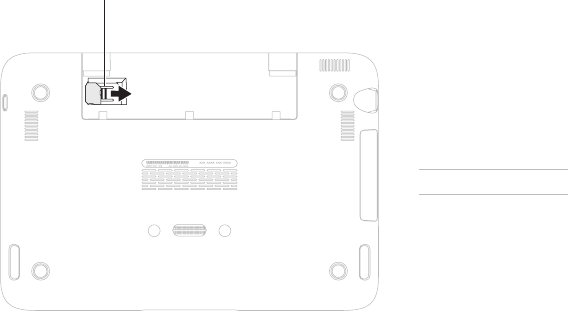
12
Setting Up Your Laptop
13
Setting Up Your Laptop
To remove the SIM card, press the release notch and slide the SIM card out of the SIM card slot.
1
1release notch
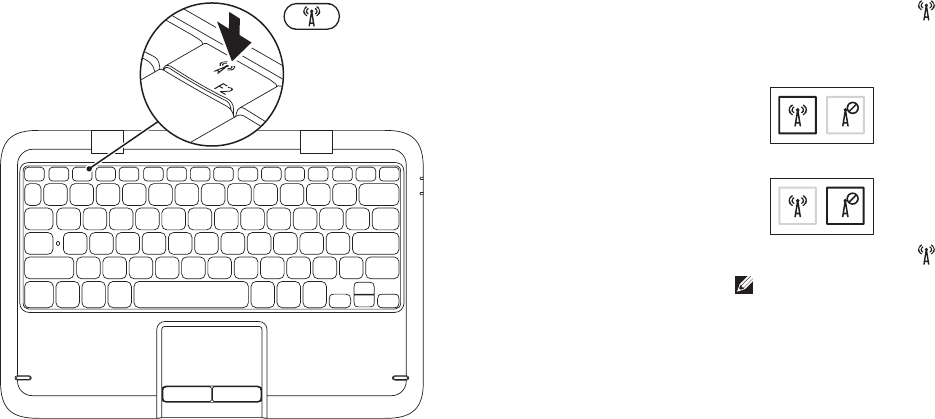
14
Setting Up Your Laptop
15
Setting Up Your Laptop
Enable or Disable Wireless (Optional) To enable or disable wireless:
Ensure that your computer is turned on.1.
Press the wireless key 2. on the function key row on the keyboard.
The current status of the wireless radios appears on the screen.
Wireless enabled
Wireless disabled
Press the wireless key 3. again to switch between the wireless enabled or disabled states.
NOTE: The wireless key allows you to quickly turn off wireless radios (Wi-Fi and Bluetooth®),
such as when you are asked to disable all wireless radios on an airplane flight.
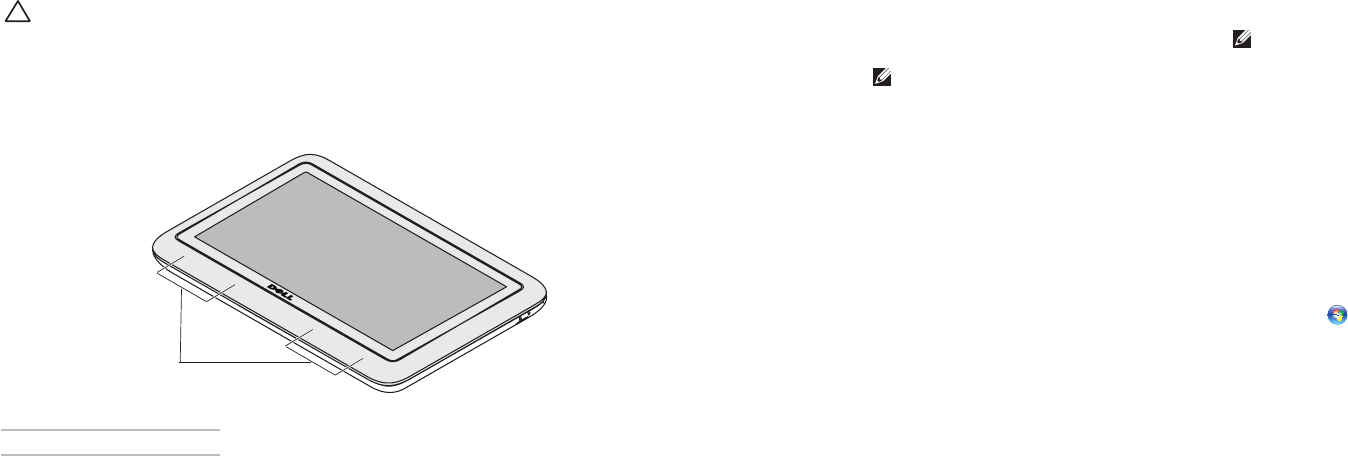
16
Setting Up Your Laptop
17
Setting Up Your Laptop
CAUTION: Blocking the wireless antennas may affect the performance of the wireless
connection.
1
1wireless antenna location
Connect to the Internet
(Optional)
NOTE: Your laptop does not have an
integrated network connector.
Setting Up a Wired Connection
If you are using a dial-up connection, •
connect the telephone line to the optional
external USB modem and to the telephone
wall connector before you set up your
Internet connection.
If you are using a DSL or cable/satellite •
modem connection, contact your ISP
or cellular telephone service for setup
instructions.
To complete setting up your wired Internet
connection, follow the instructions in “Setting
Up Your Internet Connection” on page 18.
Setting Up a Wireless Connection
NOTE: To set up your wireless router, see
the documentation that shipped with your
router.
Before you can use your wireless Internet
connection, you need to connect to your
wireless router.
To set up your connection to a wireless router:
Ensure that wireless is enabled on your 1.
computer (see “Enable or Disable Wireless”
on page 14).
Save and close any open files, and exit any 2.
open programs.
Click 3. Start → Control Panel.
In the search box, type 4. network, and
then click Network and Sharing Center→
Connect to a network.
Follow the instructions on the screen to 5.
complete the setup.

18
Setting Up Your Laptop
19
Setting Up Your Laptop
User Interface Modes
Your Inspiron laptop can be used in three different modes. Each mode has a different user interface
that changes automatically.
Standard Mode — This is the default mode. In this mode, the laptop displays the Microsoft Windows
desktop.
Tablet Mode — In this mode, the Dell Stage user interface launches (see “Dell Stage” on page 36).
For more information on Tablet Mode, Dell Stage, and how to access the Windows desktop in Tablet
Mode, see the
Inspiron Mini Duo Tablet Mode
Quick Reference Guide
at
support.dell.com/manuals. To set up your laptop in Tablet Mode, see “Set Up the Tablet Mode” on
page 20.
Docked Mode — In this mode the docked tablet launches the Dell Stage user interface. For more
information, see the
Inspiron Mini Duo Sound Station User’s Guide
at
support.dell.com/manuals. To set up your laptop in Docked Mode, first set the laptop to Tablet Mode
and then dock the tablet on the Inspiron Mini Duo Sound Station.
Setting Up Your Internet Connection
ISPs and ISP offerings vary by country. Contact
your ISP for offerings available in your country.
If you cannot connect to the Internet but have
successfully connected in the past, the ISP
might have a service outage. Contact your ISP
to check the service status, or try connecting
again later.
Have your ISP information ready. If you do not
have an ISP, the Connect to the Internet wizard
can help you get one.
To set up your Internet connection:
Save and close any open files, and exit any 1.
open programs.
Click 2. Start → Control Panel.
In the search box, type 3. network, and then
click Network and Sharing Center→ Set up
a new connection or network→ Connect to
the Internet.
The Connect to the Internet window appears.
NOTE: If you do not know which type of
connection to select, click Help me choose
or contact your ISP.
Follow the instructions on the screen and 4.
use the setup information provided by your
ISP to complete the setup.

20
Setting Up Your Laptop
21
Setting Up Your Laptop
Set Up the Tablet Mode
Your Inspiron laptop can also be set to work in
Tablet Mode.
Open the display.1. Push the display panel from the top and 2.
rotate it clockwise 180 degrees.
Close the display.3.
The Dell Stage user interface will be activated
automatically in Tablet Mode. For more
information on Tablet Mode, see the
Inspiron
Mini Duo Tablet Mode
Q
uick Reference Guide
at
support.dell.com/manuals.

22 23
Using Your Inspiron Laptop
Using Your Inspiron Laptop
This section provides information about the features available on your Inspiron laptop.
Right View Features
2
3
4
1
1 Power/battery status light — Indicates the power and the battery charge status. For
more information on the power/battery status light, see “Status Lights and Indicators” on page
26.
2 Hard drive activity light — Turns on when the computer reads or writes data. A solid
white light indicates hard drive activity.
CAUTION: To avoid loss of data, never turn off the computer when the hard drive activity
light is on.
3 Power button — Turns the computer on or off when pressed.
4Right Speaker — Provides stereo quality sound.
INSPIRON

24
Using Your Inspiron Laptop
25
Using Your Inspiron Laptop
Left View Features
1542 3
1 AC adapter connector — Connects to the AC adapter to power the computer and charge the
battery.
2 Audio-out/Headphone connector — Connects to a pair of headphones or to a powered
speaker or sound system.
3Connector covers (2) — Covers the USB connectors and the audio-out/headphone connector.
4 USB 2.0 connectors (2) — Connect to USB devices, such as a mouse, keyboard, printer,
external drive, or MP3 player.
5Left speaker — Provides stereo quality sound.

26
Using Your Inspiron Laptop
27
Using Your Inspiron Laptop
Status Lights and Indicators
Power/Battery Status Light
Indicator light status Computer state(s) Battery charge level
AC adapter solid white on
standby/off/hibernate
0-100%
<= 98%
breathing white standby > 98%
off off/hibernate > 98%
Battery solid white on >= 10%
solid amber on/standby < 10%
breathing white standby >= 10%
off off/hibernate 0-100%
NOTE: The battery is charging when the computer is powered using the AC adapter.
NOTE: For information on power problems, see “Power Problems” on page 44.
Disabling Battery Charging
You may be required to disable the battery charging feature while on an airplane flight. To quickly
disable the battery charging feature:
Ensure that your computer is turned on.1.
Press the battery health meter key 2. on the function key row on the keyboard.
In the 3. Battery Life tab, select the Disable battery charging check box.
NOTE: Battery charging can also be disabled in the System Setup (BIOS) utility.

28
Using Your Inspiron Laptop
29
Using Your Inspiron Laptop
Computer Base and Keyboard Features
1
2
4
6
5
3
1Function key row — The wireless enable or disable key , brightness increase and
decrease keys, multimedia keys, and the touch pad enable or disable key , are
located in this row.
For more information on the multimedia keys, see “Multimedia Control Keys” on page 32.
2Caps Lock status light — Turns on when Caps Lock is enabled. A solid white light indicates
that Caps Lock is enabled.
3Touch pad — Provides the functionality of a mouse to move the cursor, drag or move selected
items, and left-click by tapping the surface.
The touch pad supports the Scroll, Flick, Zoom, and Rotate features. To change the touch
pad settings, double-click the Dell Touch pad icon in the notification area of your desktop. For
more information, see “Touch Pad Gestures” on page 30.
NOTE: To enable or disable the touch pad, press the key on the function key row on the
keyboard.
4Touch pad buttons — Provide left-click and right-click functions like those on a mouse.
5Power/Battery status light — Indicates the power and the battery charge status. For more
information on the power/battery status light, see “Status Lights and Indicators” on page 26.
6Hard drive activity light — Turns on when the computer reads or writes data. A solid white
light indicates hard drive activity.
CAUTION: To avoid loss of data, never turn off the computer when the hard drive activity
light is on.
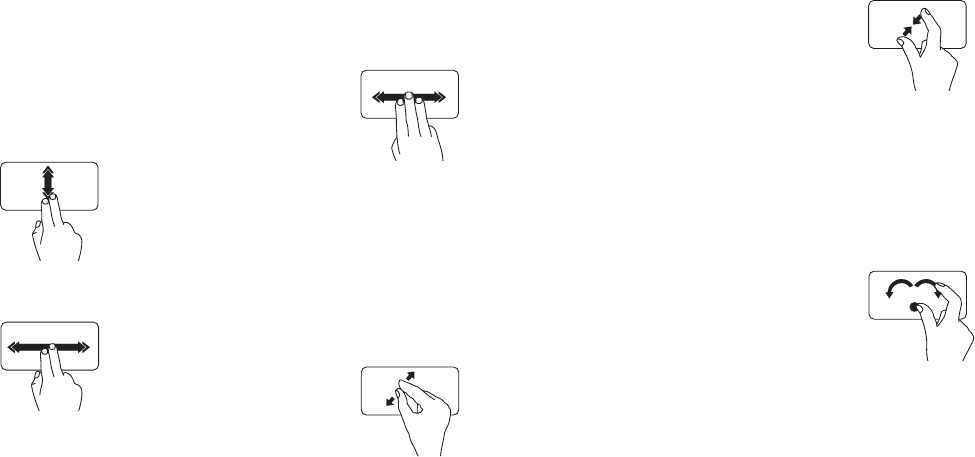
30
Using Your Inspiron Laptop
31
Using Your Inspiron Laptop
Touch Pad Gestures
Scroll
Allows you to scroll through content. The scroll
feature includes:
Auto Scroll Vertical — Allows you to scroll up
or down on the active window.
Move two fingers up or down
at a fast pace to activate
vertical auto scrolling.
Tap on the touch pad to stop
auto scrolling.
Auto Scroll Horizontal — Allows you to scroll
left or right on the active window.
Move two fingers to your left or
right at a fast pace to activate
horizontal auto scrolling.
Tap on the touch pad to stop
auto scrolling.
Flick
Allows you to flip content forward or backward
based on the direction of the flick.
Move three fingers quickly in
the desired direction to flip
content in the active window.
Zoom
Allows you to increase or decrease the
magnification of the screen content. The zoom
feature includes:
Pinch — Allows you to zoom in or zoom out
by moving two fingers apart or bringing them
closer together on the touch pad.
To zoom in:
Move two fingers apart to
enlarge the view of the active
window.
To zoom out:
Move two fingers close
together to reduce the view of
the active window.
Rotate
Allows you to rotate the active content on the
screen. The rotate feature includes:
Twist — Allows you to rotate the active content
using two fingers where one finger is anchored
and the other rotates.
Keeping the thumb in
place, move the index
finger in an arced direction
right or left to rotate the
selected item clockwise or
counterclockwise.

32
Using Your Inspiron Laptop
33
Using Your Inspiron Laptop
Multimedia Control Keys
The multimedia control keys are located on the function key row on the keyboard. To use the
multimedia controls, press the required key. You can configure the multimedia control keys on the
keyboard using the System Setup (BIOS) utility or the Windows Mobility Center.
System Setup
Press <F2> during POST (Power On Self Test) to enter the System Setup (BIOS) utility.1.
In the 2. Function Key Behavior, select Multimedia Key First or Function Key First.
Multimedia Key First — This is the default option. Press any multimedia key to perform the
associated multimedia action. For function, press <Fn> + the required function key.
Function Key First — Press any function key to perform the associated function.
For multimedia action, press <Fn> + the required multimedia key.
NOTE: The Multimedia Key First option is active only in the operating system.
Windows Mobility Center
Press the <1. ><X> keys to launch the Windows Mobility Center.
In the 2. Function Key Row, select Function Key or Multimedia Key.
Multimedia Control Keys
Mute the sound Play the previous track or chapter
Decrease the volume level Play or pause
Increase the volume level Play the next track or chapter

34
Using Your Inspiron Laptop
35
Using Your Inspiron Laptop
Display Features
1 2 3
7
6
4
5
1Microphone — Provides quality sound for video chatting and voice recording.
2Camera — Built-in camera for video capture, conferencing, and chat.
3Camera indicator light — Indicates if the camera is on or off.
4Display bezel — Outer frame which holds the display panel.
5Display panel — Rotate the display panel to set your laptop to the tablet mode. For more
information, see “Set Up the Tablet Mode” on page 20.
6Infrared sensor — Turns on when the proximity sensor is enabled.
7Ambient light/Proximity sensor — Ambient light sensor detects the available environment
light and adjusts the brightness of the display backlighting. Proximity sensor detects the
presence of a user in front of the computer and turns the display on or off. The display turns
off if you are away from your computer for specified period of time and turns on when you are
about 0.75 meters or closer to your laptop. Press F6 to turn on/off the proximity sensor.

36
Using Your Inspiron Laptop
37
Using Your Inspiron Laptop
Using the Touch Screen
The touch screen feature on your laptop
converts your computer into an interactive
display.
Dell Stage
The Dell Stage software installed on your
computer provides access to your favorite
media and multi-touch applications.
To launch Dell Stage, click Start →
All Programs→ Dell Stage→ Dell Stage.
NOTE: Some of the applications on Dell
Stage can also be launched from the All
Programs menu.
You can customize Dell Stage as follows:
Rearrange an application shortcut — Select •
and hold the application shortcut until it
blinks and then drag the application shortcut
to a desired location on Dell Stage.
Minimize — Drag the Dell Stage window to •
the bottom of the screen.
Personalize — Select the settings icon and •
then choose the desired option.
The following are the applications available on
Dell Stage:
NOTE: Some of the applications may not be
available based on the selections you made
while purchasing your computer.
MUSIC• — Play music or browse through
your music files by album, artist, or song
title. You can also listen to radio stations
from across the globe. The optional Napster
application allows you to download songs
when connected to the Internet.
YOUPAINT• — Draw and edit pictures.
GAMES• — Play touch-enabled games.
DOCUMENTS• — Provides quick access to
the Documents folder on your computer.
PHOTO• — View, organize, or edit your
pictures. You can create slideshows and
collections of your pictures and upload them
to Facebook or Flickr when connected to the
Internet.
DELL WEB• — Provides a preview of up to
four of your favorite web pages. Click or tap
the web page preview to open it in the web
browser.
VIDEO• — View videos. The optional
CinemaNow application allows you to
purchase or rent movies and TV shows when
connected to the Internet.
SHORTCUTS• — Provides quick access to your
frequently-used programs.
BOOKS — Launches E Reader which allows •
you to download and read e-books in PDF and
EPUB formats.
Web Tile — Provides a preview of up to four •
of your favorite web pages. The tile allows you
to add, edit, or delete a web page preview.
Click or tap the web page preview to open it in
the web browser. You can also create multiple
Web Tiles through the Apps Gallery.

38
Using Your Inspiron Laptop
39
Using Your Inspiron Laptop
Touch Screen Gestures
NOTE: Some of these gestures may not
work outside the Dell Touch Zone software.
Zoom
Allows you to increase or decrease the
magnification of the screen content.
Pinch — Allows you to zoom in or zoom out
by moving two fingers apart or bringing them
closer together on the screen.
To zoom in:
Move two fingers apart
to enlarge the view of the
active window.
To zoom out:
Move two fingers close
together to reduce the
view of the active window.
Dwell
Allows you to access additional information by
simulating a right-click.
Press and hold a finger on
the touch screen, to open
context-sensitive menus.
Flick
Allows you to flip content forward or backward
based on the direction of the flick.
Move a finger quickly in
the desired direction to
flip through content in the
active window like pages
in a book. Flick also works
vertically when navigating
content such as images or
songs in a playlist.
Scroll
Allows you to scroll through content. The scroll
features include:
Pan — Allows you to move the focus on the
selected object when the entire object is not
visible.
Move two fingers in the
desired direction to pan
scroll the selected object.
Scroll Vertical — Allows you to scroll up or
scroll down on the active window.
Move a finger up or down to
activate vertical scrolling.
Scroll Horizontal — Allows you to scroll left or
right on the active window.
Move a finger to the left or
right to activate horizontal
scrolling.
Rotate
Allows you to rotate the active content on the
screen.
Twist — Allows you to rotate the active
content using two fingers.
Keeping a finger or thumb
in place, move the other
finger in an arced direction
right or left. You can also
rotate the active content by
moving both the fingers in a
circular motion.

40
Using Your Inspiron Laptop
41
Using Your Inspiron Laptop
Software Features
Productivity and Communication
You can use your computer to create
presentations, brochures, greeting cards, fliers,
and spreadsheets. You can also edit and view
digital photographs and images. Check your
purchase order for software installed on
your computer.
After connecting to the Internet, you can access
websites, setup an e-mail account, and upload
or download files.
Entertainment and Multimedia
NOTE: Your computer does not have an
internal optical drive. Use an external
optical drive or any external storage device
for procedures that involve discs.
You can use your computer to watch videos,
play games, create your own CDs/DVDs, listen
to music and Internet radio stations.
You can download or copy pictures and video files
from portable devices, such as digital cameras
and cell phones. Optional software applications
enable you to organize and create music and
video files that can be recorded to disc, saved
on portable products such as MP3 players and
handheld entertainment devices, or played and
viewed directly on connected TVs, projectors,
and home theater equipment.
Dell DataSafe Online Backup
NOTE: Dell DataSafe Online is supported
only on Windows operating systems.
NOTE: A broadband connection is
recommended for fast upload/download
speeds.
Dell DataSafe Online is an automated backup
and recovery service that helps protect your
data and other important files from catastrophic
incidents like theft, fire, or natural disasters. You
can access the service on your computer using
a password-protected account.
For more information, go to DellDataSafe.com.
To schedule backups:
Double-click the Dell DataSafe Online 1.
icon in the notification area of your
desktop.
Follow the instructions on the screen.2.
Free Fall Sensor
Free fall sensor protects your computer hard
drive from possible damage, by detecting a free
fall state caused by accidentally dropping the
computer. When a free fall state is detected, the
hard drive is placed in a
safe state
to protect
against damage to the read/write head and
possible data loss. Your hard drive returns to
normal operation, when the free fall state is no
longer detected.
NOTE: This feature detects free fall events
from 4 inches or higher and places the hard
drive in a
safe state
within 145 ms. The
hard disk is still limited by its own reliability
specification. It can sustain operating
shock of 225 G and non-operating shock of
800 G.

42 43
Solving Problems
This section provides troubleshooting
information for your computer. If you cannot
solve your problem using the following
guidelines, see “Using Support Tools” on
page 49 or “Contacting Dell” on page 74.
WARNING: Only trained service
personnel should remove the computer
cover. See the
Service Manual
at
support.dell.com/manuals for advanced
service instructions.
Beep Codes
Your computer might emit a series of beeps
during start-up if there are errors or problems.
This series of beeps, called a beep code,
identifies a problem. If this occurs, note
down the beep code and contact Dell (see
“Contacting Dell” on page 74) for assistance.
NOTE: To replace parts, see the
Service
Manual
at support.dell.com.
Beep Code Possible Problem
One Possible system board failure —
BIOS ROM checksum failure
Two No RAM detected
NOTE: If you installed or
replaced the memory module,
ensure that the memory module
is seated properly.
Three Possible system board failure —
Chipset error
Four RAM read/write failure
Five Real Time Clock failure
Six Video card or chip failure
Seven Processor failure
Eight Display failure
Solving Problems Touch Screen Problems
Some or all multi-touch features are not
working —
Certain touch and multi-touch features may •
be disabled. To enable them, double-click
the Flicks icon in the notification area of
your desktop. In the Pen and Touch window,
select the Touch tab and ensure that Use
your finger as an input device and Enable
multi-touch gestures and inking options are
selected.
The multi-touch feature may not be •
supported by the application.
The touch screen is calibrated at the factory, •
and does not require re-calibration.
If the touch screen starts losing its
sensitivity —
The touch screen may have foreign particles •
(such as sticky notes) that are blocking the
touch sensors. To remove these particles:
Turn off the computer.a.
Disconnect the AC adapter cable from the b.
wall outlet.
CAUTION: Do not use water or a cleaning
liquid to wipe the touch screen.
Use a clean, lint-free cloth (you may spray c.
mild, non abrasive cleaner or water on the
cloth if needed, but not on the screen) and
wipe the surface and sides of the touch
screen to remove any dirt or fingerprints.
INSPIRON
44
Solving Problems
45
Solving Problems
Network Problems
If the wireless network connection is lost —
The wireless router is offline or wireless has
been disabled on the computer.
Check your wireless router to ensure it is •
powered on and connected to your data
source (cable modem or network hub).
Check if wireless is enabled on the computer •
(see “Enable or Disable Wireless” on
page 14).
Re-establish your connection to the •
wireless router (see “Setting Up a Wireless
Connection” on page 17).
Interference may be blocking or interrupting •
your wireless connection. Try moving the
computer closer to your wireless router.
Ensure that the wireless antennas are not •
blocked. For location of wireless antennas,
see page 16.
Power Problems
If the power light is off — The computer is
either turned off, in hibernate mode, or is not
receiving power.
Press the power button. The computer •
resumes normal operation if it is off or in
hibernate mode.
Reseat the AC adapter cable into the power •
connector on the computer, into the AC
adapter, and to the electrical outlet.
If the AC adapter cable is plugged into a •
power strip, ensure that the power strip is
plugged into an electrical outlet and that the
power strip is turned on. Also bypass power
protection devices, power strips, and power
extension cables to verify that the computer
turns on properly.
Ensure that the electrical outlet is working •
by testing it with another device, such as
a lamp.
Check the AC adapter cable connections. •
If the AC adapter has a light, ensure that the
light on the AC adapter is on.
If the power light is solid white and the
computer is not responding — The display may
not be responding.
Press the power button until the computer •
turns off and then turn it back on.
If the problem persists, contact Dell (see •
“Contacting Dell” on page 74).
If the power light is breathing white — The
computer is in standby mode or the display may
not be responding.
Press a key on the keyboard, move the •
connected mouse or a finger on the touch
pad, or press the power button to resume
normal operation.
If the display is not responding, press the •
power button until the computer turns off
and then turn it back on.
If the problem persists, contact Dell (see •
“Contacting Dell”on page 74).
If you encounter interference that hinders
reception on your computer — An unwanted
signal is creating interference by interrupting or
blocking other signals. Some possible causes of
interference are:
Power, keyboard, and mouse extension cables.•
Too many devices connected to a power strip.•
Multiple power strips connected to the same •
electrical outlet.

46
Solving Problems
47
Solving Problems
Memory Problems
If you receive an insufficient memory
message —
Save and close any open files and exit any •
open programs you are not using to see if
that resolves the problem.
See the software documentation for minimum •
memory requirements.
If the problem persists, contact Dell (see •
“Contacting Dell” on page 74).
If you experience other memory problems —
Run Dell Diagnostics (see “Dell Diagnostics” •
on page 53).
If the problem persists, contact Dell (see •
“Contacting Dell” on page 74).
Lockups and Software
Problems
If the computer does not start up — Ensure that
the AC adapter cable is firmly connected to the
computer and to the electrical outlet.
If a program stops responding —
End the program:
Press <Ctrl><Shift><Esc> simultaneously.1.
Click 2. Applications.
Select the program that is no longer 3.
responding
Click 4. End Task.
If a program crashes repeatedly — Check the
software documentation. If necessary, uninstall
and then reinstall the program.
NOTE: Software usually includes
installation instructions in its
documentation or on the CD.
NOTE: Your computer does not have an
internal optical drive. Use an external
optical drive or any external storage device
for procedures that involve discs.
If the computer stops responding or a solid blue
screen appears —
CAUTION: You might lose data if you are
unable to perform an operating system
shutdown.
If you are unable to get a response by pressing a
key on your keyboard, or by moving the connected
mouse or a finger on the touch pad, press the
power button for at least 8 to 10 seconds until the
computer turns off and then restart your computer.
If a program is designed for an earlier
Microsoft® Windows® operating system —
Run the Program Compatibility Wizard. The
Program Compatibility Wizard configures a
program so that it runs in an environment similar
to an earlier version of Microsoft Windows
operating system.

48
Solving Problems
49
To run the Program Compatibility Wizard:
Click 1. Start → Control Panel→
Programs→ Run programs made for
previous versions of Windows.
In the welcome screen, click 2. Next.
Follow the instructions on the screen.3.
If you have other software problems —
Back up your files immediately.•
Use a virus-scanning program to check the •
hard drive or CDs.
Save and close any open files or programs •
and shut down your computer through the
Start menu.
Check the software documentation or •
contact the software manufacturer for
troubleshooting information:
Ensure that the program is compatible –
with the operating system installed on
your computer.
Ensure that your computer meets the –
minimum hardware requirements needed
to run the software. See the software
documentation for information.
Ensure that the program is installed and –
configured properly.
Verify that the device drivers do not –
conflict with the program.
If necessary, uninstall and then reinstall –
the program.
Write down any error message that is –
displayed to help in troubleshooting when
contacting Dell.
Dell Support Center
The Dell Support Center helps you find
the service, support, and system-specific
information you need.
To launch the application, click the icon in the
notification area of your desktop.
The Dell Support Center home page displays your
computer’s model number, service tag, express
service code, and service contact information.
The home page also provides links to access:
Self Help (Troubleshooting,
Security, System Performance,
Network/Internet, Backup/
Recovery, and Windows
operating system)
Alerts (technical support alerts
relevant to your computer)
Assistance from Dell (Technical
Support with DellConnect™,
Customer Service, Training and
Tutorials, How-To Help with
Solution Station™, and Online
Scan with PC CheckUp)
About Your System (System
Documentation, Warranty
Information, System Information,
Upgrades & Accessories)
For more information about Dell Support Center
and available support tools, go to
DellSupportCenter.com.
Using Support Tools
INSPIRON

50
Using Support Tools
51
Using Support Tools
My Dell Downloads
NOTE: My Dell Downloads may not be
available in all regions.
Some of the software pre-installed on your new
Dell computer do not include a backup CD or
DVD. This software is available on the My Dell
Downloads website. From this website you can
download available software for reinstallation
or create your own backup media.
To register and use My Dell Downloads:
Go to 1. DownloadStore.dell.com/media.
Follow the instructions on the screen to 2.
register and download the software.
Reinstall the software or create a backup 3.
media for future use.
System Messages
If your computer has an issue or error, it may display
a system message that will help you identify the
cause and action needed to resolve the issue.
NOTE: If the message that appeared is not
listed in the following examples, see the
documentation for either the operating
system or the program that was running
when the message appeared. Alternatively
you could contact Dell (see “Contacting Dell”
on page 74) for assistance.
Alert! Previous attempts at booting this system
have failed at checkpoint [nnnn]. For help
in resolving this problem, please note this
checkpoint and contact Dell Technical
Support — The computer failed to complete
the boot routine three consecutive times for the
same error. Contact Dell (see “Contacting Dell”
on page 74) for assistance.
CMOS checksum error — Possible system
board failure or RTC battery low. Replace the
battery (see the Service Manual at
support.dell.com/manuals) or Contact Dell (see
“Contacting Dell” on page 74) for assistance.
CPU fan failure — CPU fan has failed. Replace
the CPU fan (see the Service Manual at
support.dell.com/manuals).
Hard-disk drive failure — Possible hard-disk
drive failure during POST. Contact Dell (see
“Contacting Dell” on page 74) for assistance.
Hard-disk drive read failure — Possible hard-
disk drive failure during HDD boot test. Contact
Dell (see “Contacting Dell” on page 74) for
assistance.
Keyboard failure — Keyboard failure or
loose cable.
To replace the keyboard, see the Service
Manual at support.dell.com/manuals.

52
Using Support Tools
53
Using Support Tools
No boot device available — No bootable
partition on hard drive, the hard drive cable is
loose, or no bootable device exists.
Enter the System Setup (BIOS) utility and •
ensure that the boot sequence information
is correct. To enter the System Setup (BIOS)
utility, press <F2> during POST (Power On
Self Test).
No timer tick interrupt — A chip on the system
board might be malfunctioning or there might
be a system board failure. Contact Dell (see
“Contacting Dell” on page 74) for assistance.
USB over current error — Disconnect the USB
device. Your USB device needs more power for
it to function properly. Use an external power
source to connect the USB device, or if your
device has two USB cables, connect both
of them.
CAUTION - Hard Drive SELF MONITORING
SYSTEM has reported that a parameter has
exceeded its normal operating range. Dell
recommends that you back up your data
regularly. A parameter out of range may
or may not indicate a potential hard drive
problem — S.M.A.R.T error, possible hard drive
failure. Contact Dell (see “Contacting Dell” on
page 74) for assistance.
Hardware Troubleshooter
If a device is either not detected during
the operating system setup or is detected
but incorrectly configured, you can use the
Hardware Troubleshooter to resolve the
incompatibility.
To start the Hardware Troubleshooter:
Click 1. Start → Help and Support.
Type 2. hardware troubleshooter in
the search field and press <Enter> to start
the search.
In the search results, select the option that 3.
best describes the problem and follow the
remaining troubleshooting steps.
Dell Diagnostics
If you experience a problem with your computer,
perform the checks in “Lockups and Software
Problems” on page 46 and run Dell Diagnostics
before you contact Dell for technical assistance.
NOTE: Dell Diagnostics works only on Dell
computers.
NOTE: The
Drivers and Utilities
disc may
not ship with your computer.
Ensure that the device that you want to test
displays in the system setup program and is
active. Press <F2> during POST (Power On Self
Test) to enter the System Setup (BIOS) utility.
Start Dell Diagnostics from your hard drive or
from the
Drivers and Utilities
disc.

54
Using Support Tools
55
Using Support Tools
Starting Dell Diagnostics From Your
Hard Drive
Dell Diagnostics is located on a hidden
diagnostic utility partition on your hard drive.
NOTE: If your computer cannot display
a screen image, contact Dell (see
“Contacting Dell” on page 74) for
assistance.
Ensure that the computer is connected to an 1.
electrical outlet that is known to be working
properly.
Turn on (or restart) your computer.2.
When the DELL3. ™ logo appears, press <F12>
immediately. Select Diagnostics from the
boot menu and press <Enter>. This may
invoke the Pre-Boot System Assessment
(PSA) on your computer.
NOTE: If you wait too long and the operating
system logo appears, continue to wait until
you see the Microsoft® Windows® desktop;
then, shut down your computer and try again.
NOTE: If you see a message stating that no
diagnostics utility partition has been found,
run Dell Diagnostics from the
Drivers and
Utilities
disc.
If PSA is invoked:
The PSA will start running tests.a.
If the PSA completes successfully, b.
the following message appears: “No
problems have been found
with this system so far.
Do you want to run the
remaining memory tests? This
will take about 30 minutes
or more. Do you want to
continue? (Recommended).”
If you are experiencing memory issues, c.
press <y>, otherwise press <n>. The
following message appears: “Booting
Dell Diagnostic Utility
Partition. Press any key to
continue.”
Press any key to go to the d. Choose An
Option window.
If PSA is not invoked:
Press any key to start Dell Diagnostics from
the diagnostic utility partition on your hard
drive and to go to the Choose An Option
window.
Select the test you want to run.4.
If a problem is encountered during a 5.
test, a message with an error code and a
description of the problem appears on your
screen. Write down the error code and
problem description and contact Dell (see
“Contacting Dell” on page 74) for assistance.
NOTE: The Service Tag for your computer
is displayed at the top of each test screen.
The Service Tag helps you identify your
computer when you contact Dell.
When the tests complete, close the test 6.
screen to return to the Choose An Option
window.
To exit Dell Diagnostics and restart the 7.
computer, click Exit.

56
Using Support Tools
57
Using Support Tools
Starting Dell Diagnostics From the
Drivers and Utilities Disc
NOTE: The
Drivers and Utilities
disc may
not ship with your computer.
NOTE: Your computer does not have an
internal optical drive. Use an external
optical drive or any external storage device
for procedures that involve discs.
Insert the1.
Drivers and Utilities
disc.
Shut down and restart the computer. 2.
When the DELL™ logo appears, press <F12>
immediately.
NOTE: If you wait too long and the
operating system logo appears, continue to
wait until you see the Microsoft Windows
desktop; then, shut down your computer
and try again.
NOTE: The next steps change the boot
sequence for one time only. On the next
start-up, the computer boots according to
the devices specified in the system setup
program.
When the boot device list appears, highlight 3.
CD/DVD/CD-RW and press <Enter>.
Select the 4. Boot from CD-ROM option from
the menu that appears and press <Enter>.
Type 1 to start the CD menu and press 5.
<Enter> to proceed.
Select 6. Run the 32 Bit Dell Diagnostics from
the numbered list. If multiple versions are
listed, select the version appropriate for your
computer.
Select the test you want to run.7.
If a problem is encountered during a 8.
test, a message with an error code and a
description of the problem appears on your
screen. Write down the error code and
problem description and contact Dell (see
“Contacting Dell” on page 74) for assistance.
NOTE: The Service Tag for your computer
is displayed at the top of each test screen.
The Service Tag helps you identify your
computer when you contact Dell.
When the tests complete, close the test 9.
screen to return to the Choose An Option
window.
To exit Dell Diagnostics and restart the 10.
computer, click Exit.
Remove the11.
Drivers and Utilities
disc.

58 59
Restoring Your Operating System
You can restore the operating system on your computer using any of the following options:
CAUTION: Using Dell Factory Image Restore or the
Operating System
disc to restore your
operating system permanently deletes all data files on your computer. If possible, backup your
data files before using these options.
Option Use
System Restore as the first solution
Dell DataSafe Local Backup when System Restore does not resolve your problem
System recovery media when operating system failure prevents the use of System
Restore and Dell DataSafe Local Backup
when installing the Dell factory-installed software on a
newly installed hard drive
Dell Factory Image Restore to restore your computer to the operating state it was in
when you received your computer
Operating System
disc to reinstall only the operating system on your computer
NOTE: The
Operating System
disc may not ship with your computer.
Restoring Your Operating System System Restore
The Microsoft® Windows® operating systems
provide a System Restore option which allows
you to return your computer to an earlier
operating state (without affecting data files) if
changes to the hardware, software, or other
system settings have left the computer in an
undesirable operating state. Any changes that
System Restore makes to your computer are
completely reversible.
CAUTION: Make regular backups of your
data files. System Restore does not monitor
your data files or recover them.
Starting System Restore
Click 1. Start .
In the search box, type 2. System Restore
and press <Enter>.
NOTE: The User Account Control window
may appear. If you are an administrator on
the computer, click Continue; otherwise,
contact your administrator to continue the
desired action.
Click 3. Next and follow the instructions on the
screen.
In the event that System Restore did not resolve
the issue, you may undo the last system restore.
INSPIRON

60
Restoring Your Operating System
61
Restoring Your Operating System
Undoing the Last System Restore
NOTE: Before you undo the last system
restore, save and close all open files and
exit any open programs. Do not alter, open,
or delete any files or programs until the
system restoration is complete.
Click 1. Start .
In the search box, type 2. System Restore
and press <Enter>.
Click 3. Undo my last restoration and click
Next.
Dell DataSafe Local Backup
CAUTION: Using Dell DataSafe Local
Backup to restore your operating system
permanently removes any programs
or drivers installed after you received
your computer. Create backup media of
applications you need to install on your
computer before using Dell DataSafe Local
Backup. Use Dell DataSafe Local Backup
only if System Restore did not resolve your
operating system problem.
CAUTION: Although Dell Datasafe Local
Backup is designed to preserve the data
files on your computer, it is recommended
that you backup your data files before
using Dell DataSafe Local Backup.
NOTE: Dell DataSafe Local Backup may not
be available in all regions.
NOTE: If Dell DataSafe Local Backup is
not available on your computer, use Dell
Factory Image Restore (see “Dell Factory
Image Restore” on page 64) to restore your
operating system.
You can use Dell DataSafe Local Backup to
restore your hard drive to the operating state
it was in when you purchased your computer,
while preserving the data files.
Dell DataSafe Local Backup allows you to:
Backup and restore your computer to an •
earlier operating state
Create system recovery media•
Dell DataSafe Local Backup Basic
To restore the Dell factory-installed software
while preserving the data files:
Turn off your computer.1.
Disconnect all the devices (USB drive, 2.
printer, and so on) connected to the
computer and remove any newly added
internal hardware.
NOTE: Do not disconnect the AC adapter.
Turn on your computer.3.
When the DELL4. ™ logo appears, press <F8>
several times to access the Advanced Boot
Options window.
NOTE: If you wait too long and the
operating system logo appears, continue to
wait until you see the Microsoft Windows
desktop; then, shut down your computer
and try again.
Select 5. Repair Your Computer.

62
Restoring Your Operating System
63
Restoring Your Operating System
Select 6. Dell DataSafe Restore and
Emergency Backup from the System
Recovery Options menu and follow the
instructions on the screen.
NOTE: The restoration process may take an
hour or more depending on the size of the
data to be restored.
NOTE: For more information, see knowledge
base article 353560 at support.dell.com.
Upgrading to Dell DataSafe Local
Backup Professional
NOTE: Dell DataSafe Local Backup
Professional may be installed on your
computer, if you ordered it at the time of
purchase.
Dell DataSafe Local Backup Professional
provides additional features that allow you to:
Backup and restore your computer based on •
file types
Backup files to a local storage device•
Schedule automated backups•
To upgrade to Dell DataSafe Local Backup
Professional:
Double-click the Dell DataSafe Local Backup 1.
icon in the notification area of your
desktop.
Click 2. UPGRADE NOW!
Follow the instructions on the screen.3.
System Recovery Media
CAUTION: Although the system recovery
media is designed to preserve the data
files on your computer, it is recommended
that you backup your data files before
using the system recovery media.
NOTE: Your computer does not have an
internal optical drive. Use an external
optical drive or any external storage device
for procedures that involve discs.
You can use the system recovery media, created
using Dell DataSafe Local Backup, to return
your hard drive to the operating state it was
in when you purchased the computer while
preserving the data files on your computer.
Use the system recovery media in case of:
Operating system failure that prevents the •
use of the recovery options installed on your
computer.
Hard drive failure that prevents data from •
being recovered.
To restore the Dell factory-installed software
of your computer using the system recovery
media:
Insert the system recovery disc or USB key 1.
and restart the computer.
When the DELL2. ™ logo appears, press <F12>
immediately.
NOTE: If you wait too long and the
operating system logo appears, continue to
wait until you see the Microsoft Windows
desktop; then, shut down your computer
and try again.
Select the appropriate boot device from the 3.
list and press <Enter>.
Follow the instructions on the screen.4.

64
Restoring Your Operating System
65
Restoring Your Operating System
Dell Factory Image Restore
CAUTION: Using Dell Factory Image
Restore to restore your operating system
permanently deletes all data on the hard
drive and removes any programs or drivers
installed after you received your computer.
If possible, back up the data before using
this option. Use Dell Factory Image Restore
only if System Restore did not resolve your
operating system problem.
NOTE: Dell Factory Image Restore may
not be available in certain countries or on
certain computers.
NOTE: If Dell Factory Image Restore is
not available on your computer, use Dell
DataSafe Local Backup (see “Dell DataSafe
Local Backup” on page 60) to restore your
operating system.
Use Dell Factory Image Restore only as the
last method to restore your operating system.
This option restores your hard drive to the
operating state it was in when you purchased
the computer. Any programs or files added
since you received your computer—including
data files—are permanently deleted from
the hard drive. Data files include documents,
spreadsheets, e-mail messages, digital photos,
music files, and so on. If possible, back up all
data before using Dell Factory Image Restore.
Starting Dell Factory Image Restore
Turn on the computer. 1.
When the DELL2. ™ logo appears, press <F8>
several times to access the Advanced Boot
Options window.
NOTE: If you wait too long and the
operating system logo appears, continue to
wait until you see the Microsoft Windows
desktop; then, shut down your computer
and try again.
Select 3. Repair Your Computer.
The System Recovery Options window
appears.
Select a keyboard layout and click 4. Next.
To access the recovery options, log on as 5.
a local user. To access the command prompt,
type administrator in the User name
field, then click OK.
Click 6. Dell Factory Image Restore.
The Dell Factory Image Restore welcome
screen appears.
NOTE: Depending upon your configuration,
you may need to select Dell Factory Tools,
then Dell Factory Image Restore.
Click 7. Next.
The Confirm Data Deletion screen appears.
NOTE: If you do not want to proceed with
the Factory Image Restore, click Cancel.
Select the check box to confirm that you 8.
want to continue to reformat the hard drive
and restore the system software to the
factory condition, then click Next.
The restore process begins and may take
five or more minutes to complete. A message
appears when the operating system and
factory-installed applications have been
restored to factory condition.
Click 9. Finish to restart the computer.

66 67
Getting Help
If you experience a problem with your computer,
you can complete the following steps to
diagnose and troubleshoot the problem:
See “Solving Problems” on page 1. 42 for
information and procedures that pertain to
the problem your computer is experiencing.
See “Dell Diagnostics” on page 2. 53 for
procedures on how to run Dell Diagnostics.
Fill out the “Diagnostic Checklist” on 3.
page 73.
Use Dell’s extensive suite of online services 4.
available at Dell Support (support.dell.com)
for help with installation and troubleshooting
procedures. See “Online Services” on
page 68 for a more extensive list of Dell
Support online.
If the preceding steps have not resolved the 5.
problem, see “Before You Call” on page 72.
NOTE: Call Dell Support from a telephone
near or at the computer so that the support
staff can assist you with any necessary
procedures.
NOTE: Dell’s Express Service Code system
may not be available in all countries.
When prompted by Dell’s automated telephone
system, enter your Express Service Code to
route the call directly to the proper support
personnel. If you do not have an Express
Service Code, open the Dell Accessories folder,
double-click the Express Service Code icon, and
follow the directions.
NOTE: Some of the services are not
always available in all locations outside
the continental U.S. Call your local Dell
representative for information on availability.
Getting Help Technical Support and
Customer Service
Dell’s support service is available to answer
your questions about Dell hardware. Our support
staff use computer-based diagnostics to provide
fast, accurate answers.
To contact Dell’s support service, see “Before
You Call” on page 72 and then see the contact
information for your region or go to
support.dell.com.
DellConnect
DellConnect™ is a simple online access tool that
allows a Dell service and support associate to
access your computer through a broadband
connection, diagnose your problem and repair it
all under your supervision. For more information,
go to www.dell.com/DellConnect.
INSPIRON
68
Getting Help
69
Getting Help
Online Services
You can learn about Dell products and services
on the following websites:
www.dell.com•
www.dell.com/ap• (Asian/Pacific countries
only)
www.dell.com/jp• (Japan only)
www.euro.dell.com• (Europe only)
www.dell.com/la• (Latin American and
Caribbean countries)
www.dell.ca• (Canada only)
You can access Dell Support through the
following websites and e-mail addresses:
Dell Support Websites
support.dell.com•
support.jp.dell.com• (Japan only)
support.euro.dell.com• (Europe only)
supportapj.dell.com• (Asia Pacific only)
Dell Support E-mail Addresses
mobile_support@us.dell.com•
support@us.dell.com•
la-techsupport@dell.com• (Latin America and
Caribbean countries only)
apsupport@dell.com• (Asian/Pacific
countries only)
Dell Marketing and Sales E-mail
Addresses
apmarketing@dell.com• (Asian/Pacific
countries only)
sales_canada@dell.com• (Canada only)
Anonymous File Transfer Protocol (FTP)
ftp.dell.com•
Log in as user: anonymous, and use your
e-mail address as your password.
Automated Order-Status
Service
To check on the status of any Dell products
that you have ordered, you can go to
support.dell.com, or you can call the automated
order-status service. A recording prompts you
for the information needed to locate and report
on your order.
If you have a problem with your order, such as
missing parts, wrong parts, or incorrect billing,
contact Dell for customer assistance. Have your
invoice or packing slip handy when you call.
For the telephone number to call for your region,
see “Contacting Dell” on page 74.
Product Information
If you need information about additional
products available from Dell, or if you would like
to place an order, go to the Dell website at
www.dell.com. For the telephone number to call
for your region or to speak to a sales specialist,
see “Contacting Dell” on page 74.

70
Getting Help
71
Getting Help
Returning Items for Repair
Under Warranty or for Credit
Prepare all items being returned, whether for
repair or credit, as follows:
NOTE: Before you return the product to Dell,
ensure that you back up any data on the
hard drive(s) and on any other storage
device in the product. Remove any and
all confidential, proprietary and personal
information, as well as removable media,
such as CDs and media cards. Dell is not
responsible for any of your confidential,
proprietary or personal information; lost
or corrupted data; or damaged or lost
removable media that may be included with
your return.
Call Dell to obtain a Return Material 1.
Authorization Number, and write it clearly
and prominently on the outside of the box.
For the telephone number to call for your
region, see “Contacting Dell” on page 74.
Include a copy of the invoice and a letter 2.
describing the reason for the return.
Include a copy of the Diagnostics Checklist 3.
(see “Diagnostic Checklist” on page 73),
indicating the tests that you have run and any
error messages reported by Dell Diagnostics
(see “Dell Diagnostics” on page 53).
Include any accessories that belong with the 4.
item(s) being returned (AC adapter cable,
software, guides, and so on) if the return is for
credit.
Pack the equipment to be returned in the 5.
original (or equivalent) packing materials.
NOTE: You are responsible for paying
shipping expenses. You are also
responsible for insuring any product
returned, and you assume the risk of loss
during shipment to Dell. Collect On Delivery
(C.O.D.) packages are not accepted.
NOTE: Returns that are missing any of the
preceding requirements will be refused at
Dell’s receiving dock and returned to you.
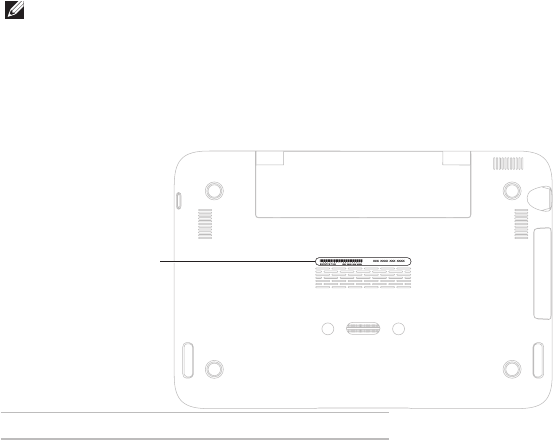
72
Getting Help
73
Getting Help
Before You Call
NOTE: Have your Express Service Code ready when you call. The code helps Dell’s automated-
support telephone system direct your call more efficiently. You may also be asked for your
Service Tag.
Locating Your Service Tag and Express Service Code
The Service Tag and Express Service Code for your computer can be found on a label at the bottom
of your computer.
1
1Service Tag and Express Service Code
Remember to fill out the following Diagnostic
Checklist. If possible, turn on your computer
before you call Dell for assistance and call from
a telephone at or near the computer. You may be
asked to type some commands at the keyboard,
relay detailed information during operations, or
try other troubleshooting steps possible only at
the computer itself. Ensure that the computer
documentation is available.
Diagnostic Checklist
Name:•
Date:•
Address:•
Phone number:•
Service Tag (bar code on the bottom of the •
computer):
Express Service Code:•
Return Material Authorization Number (if •
provided by Dell support technician):
Operating system and version:•
Devices:•
Expansion cards:•
Are you connected to a network? Yes /No•
Network, version, and network adapter:•
Programs and versions:•

74
Getting Help
75
Getting Help
See your operating system documentation
to determine the contents of the computer’s
start-up files. If the computer is connected to
a printer, print each file. Otherwise, record the
contents of each file before calling Dell.
Error message, beep code, or diagnostic •
code:
Description of problem and troubleshooting •
procedures you performed:
Contacting Dell
For customers in the United States, call
800-WWW-DELL (800-999-3355).
NOTE: If you do not have an active
Internet connection, you can find contact
information on your purchase invoice,
packing slip, bill, or Dell product catalog.
Dell provides several online and telephone-
based support and service options. Availability
varies by country and product, and some
services may not be available in your area.
To contact Dell for sales, technical support, or
customer service issues:
Go to 1. www.dell.com/ContactDell.
Select your country or region.2.
Select the appropriate service or support link 3.
based on your requirement.
Choose the method of contacting Dell that is 4.
convenient for you.

76 77
Finding More Information and Resources
Finding More Information and Resources
If you need to: See:
reinstall your operating system “System Recovery Media” on page 63
run a diagnostic program for your computer “Dell Diagnostics” on page 53
reinstall system software “My Dell Downloads” on page 50
for more information about the Microsoft®
Windows® operating system and features
support.dell.com
upgrade your computer with new or additional
components like a new hard drive
reinstall or replace a worn or defective part
the Service Manual at
support.dell.com/manuals
NOTE: In some countries, opening and
replacing parts of your computer may void
your warranty. Check your warranty and
return policies before working inside your
computer.
If you need to: See:
find safety best practices information for your
computer
review Warranty information, Terms and
Conditions (U.S. only), Safety instructions,
Regulatory information, Ergonomics
information, and End User License Agreement
the safety and regulatory documents that
shipped with your computer and also see the
Regulatory Compliance Homepage at
www.dell.com/regulatory_compliance
find your Service Tag/Express Service Code —
You must use the service tag to identify your
computer on support.dell.com or to contact
technical support
the bottom of your computer
the Dell Support Center. To launch the Dell
Support Center, click the icon in the
notification area of your desktop.
find drivers and downloads; readme files
access technical support and product help
check on your order status for new purchases
find solutions and answers to common
questions
locate information for last-minute updates
about technical changes to your computer or
advanced technical-reference material for
technicians or experienced users
support.dell.com
INSPIRON

78 79
Specications
This section provides information that you may need when setting up, updating drivers for, and
upgrading your computer.
NOTE: Offerings may vary by region. For more information regarding the configuration of
your computer, see the About Your System section in the Dell Support Center. To launch the
Dell Support Center, click the icon in the notification area of your desktop.
Specifications
Computer Model
Dell™ Inspiron 1090
Computer Information
System chipset Intel® NM10 Express
Processor type Intel Atom™ dual core N550
Memory
Memory module
connector
one internal SODIMM
connector
Memory module
capacities
2 GB
Minimum memory 2 GB
Maximum memory 2 GB
Memory type 1333 MHz SODIMM
DDR3
Memory
NOTE: For instructions on upgrading
the memory, see the
Service Manual
at
support.dell.com/manuals.
Connectors
Audio one audio-out/
headphone connector
Mini-Card one half Mini-Card slot
and one full Mini-Card
slot
USB two 4-pin USB
2.0-compliant
connectors
Communications
Wireless WLAN
Optional: WWAN,
WiMax/Wi-Fi abgn/
agn, and WPAN with
Bluetooth® wireless
technology
Video
Video controller Intel NM10
Video memory 8 MB system memory
(minimum)
256 MB (maximum)
Audio
Audio controller Connexant Audio CX20671
Speakers 2 x 1.5 Watt (peak) /1 Watt
(Average RMS)
INSPIRON

80
Specications
81
Specications
Audio
Volume controls software program menus
and media controls
Camera
Camera
resolution
1.3 megapixel
Video resolution 640 x 480 at 30 fps
(maximum)
Keyboard
Number of keys 86 (U.S. and Canada);
87 (Europe and Brazil);
90 (Japan)
Display
Type Multi-touch 10.1 inch High
Definition
Dimensions:
Display
Height 125.22 mm (4.93 inches)
Width 222.73 mm (8.77 inches)
Diagonal 10.06 inches
Maximum
resolution
1366 x 768
Refresh rate 60 Hz
Operating angle 0° (closed) to 135°
Horizontal
viewing angle
40/40
Vertical viewing
angle
15/30 (H/L)
Pixel pitch 0.163 mm x 0.163 mm
Touch Pad
X/Y position
resolution
(graphics table
mode)
240 cpi
Size:
Width 67.0 mm (2.64 inches)
sensor-active area
Height 37.0 mm (1.46 inches)
rectangle
Battery
4-cell “smart” lithium ion:
Height 12.0 mm (0.47 inches)
Width 56.0 mm (2.20 inches)
Length 220.4 mm (8.68 inches)
Weight 0.22 kg (0.48 lb)
Operating time battery operating time
varies depending on
operating conditions
Coin-cell battery CR-2032
Physical
Height 26.2 mm (1.03 inches)
Width 285.0 mm (11.22 inches)
Depth 194.5 mm (7.66 inches)
Weight configurable to less than
1.54 kg (3.39 lb)

82
Specications
83
Specications
AC Adapter
NOTE: Use only AC adapters specified
for use with your computer. See the
safety information that shipped with your
computer.
Input voltage 100-240 VAC
Input current
(maximum)
1.0 A
Input frequency 50-60 Hz
Output power 30 W
Output current:
30 W 1.58 A (maximum)
Rated output
voltage
19.0 VDC
Temperature range:
Operating 0° to 40°C
(32° to 104°F)
AC Adapter
Storage –40° to 70°C
(–40° to 158°F)
Computer Environment
Temperature range:
Operating 0° to 35°C
(32° to 95°F)
Storage –40° to 65°C
(–40° to 149°F)
Relative humidity (maximum):
Operating 10% to 90%
(noncondensing)
Storage 5% to 95%
(noncondensing)
Maximum vibration (using a random vibration
spectrum that simulates user environment):
Operating 0.66 G
Computer Environment
Non-Operating 1.30 G
Maximum shock (for operating — measured
with Dell Diagnostics running on the hard
drive and a 2-ms half-sine pulse; for
non-operating — measured with the hard
drive in head-parked position and a 2-ms half-
sine pulse):
Operating 110 G
Non-Operating 160 G
Altitude (maximum):
Operating –15.2 to 3048 m
(–50 to 10,000 ft)
Storage –15.2 to 10,668 m
(–50 to 35,000 ft)
Airborne
contaminant level
G2 or lower as defined
by ISA-S71.04-1985

84 85
Appendix
Appendix
Macrovision Product Notice
This product incorporates copyright protection technology that is protected by method claims of
certain U.S. patents and other intellectual property rights owned by Macrovision Corporation and
other rights owners. Use of this copyright protection technology must be authorized by Macrovision
Corporation, and is intended for home and other limited viewing uses only unless otherwise
authorized by Macrovision Corporation. Reverse engineering or disassembly is prohibited.
Information for NOM, or Official Mexican Standard
(Only for Mexico)
The following information is provided in the device(s) described in this document in accordance
with the requirements of the Official Mexican Standard (NOM):
Importer:
Dell México S.A. de C.V.
Paseo de la Reforma 2620 – Flat 11°
Col. Lomas Altas
11950 México, D.F.
Regulatory
model number Voltage Frequency
Electricity
consumption Output voltage
Output
intensity
P08T 100-240 VAC 50-60 Hz 1.0 A 19.0 VDC 1.58 A
For details, read the safety information that shipped with your computer.
For additional safety best practices information, see the Regulatory Compliance Homepage at
www.dell.com/regulatory_compliance.
INSPIRON

86 87
Index
A
airflow, allowing 5
B
backup and recovery 41
C
calling Dell 72
CDs, playing and creating 40
computer capabilities 40
computer, setting up 5
Contacting Dell online 74
customer service 67
D
DataSafe Local Backup
Basic 61
Professional 62
DellConnect 67
Dell Diagnostics 53
Dell Factory Image Restore 64
Dell Support Center 49
Diagnostic Checklist 73
drivers and downloads 77
DVDs, playing and creating 40
E
E-mail addresses
for technical support 68
F
finding more information 76
flick 38
Free Fall sensor 41
Index FTP login, anonymous 68
G
gestures
Touch Pad 30
touch screen 38
H
hard drive activity light 23, 29
hardware problems
diagnosing 53
Hardware Troubleshooter 53
help
getting assistance and support 66
I
Internet connection 17
M
memory problems
solving 46
P
power problems, solving 44
power strips, using 6
problems, solving 42
products
information and purchasing 69
R
resources, finding more 76
restoring factory image 64
S
Service Tag
locating 72
setup, before you begin 5
INSPIRON

88
Index
shipping products
for return or repair 70
SIM card 10
software features 40
software problems 46
solving problems 42
specifications 78
support e-mail addresses 68
support sites
worldwide 67
System Messages 50
System Recovery Media 63
system reinstall options 58
System Restore 59
T
Tablet Mode 20
touch screen 36
U
User Interface Modes 19
V
ventilation, ensuring 5
W
warranty returns 70
Windows
Program Compatibility Wizard 47
wireless network
connecting 14
problems 44

Printed in the U.S.A.
www.dell.com | support.dell.com